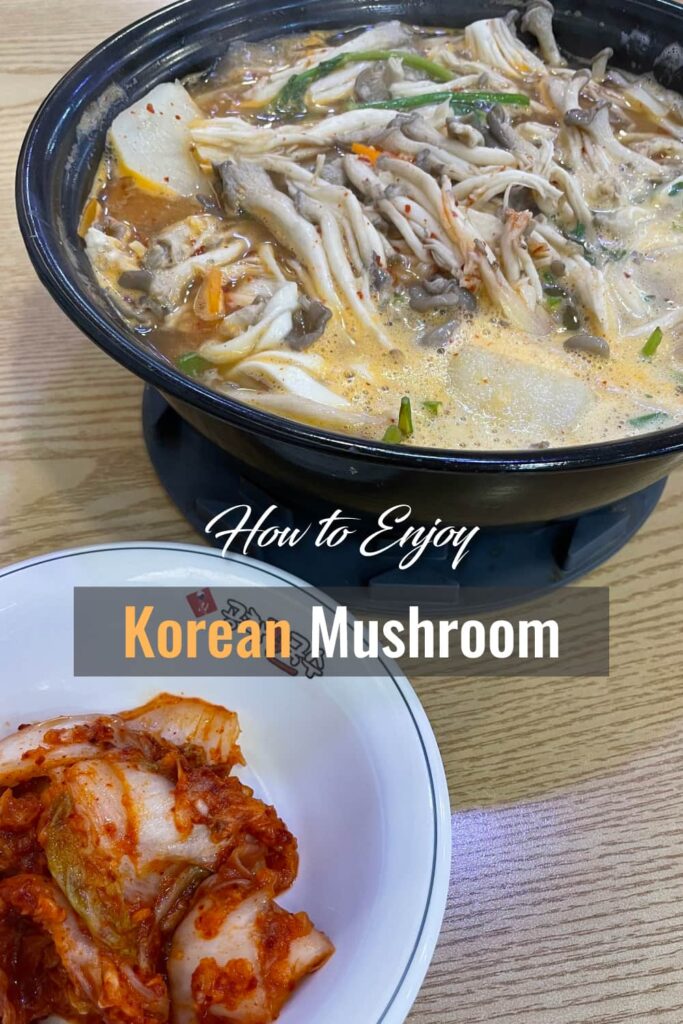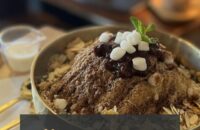Want to eat more plant-based or vegan food that tastes great too?
Beoseot or Korean mushrooms can play both the star and supporting roles in your daily meals.
Here are popular mushrooms in Korea and some recipe ideas!

Key Takeaways
- Pyogo Beoseot in Korean means Shiitake mushroom.
- Neutari Beoseot refers to oyster mushroom.
- Saesongi Beoseot is king oyster mushroom
- Songi Beoseot means pine mushroom.
I also included some non-vegetarian dishes for meat-lovers trying to eat healthier.
Fun Fact!
You’ll be met with a blank stare if you ask for vegan food in most Korean restaurants. But, Koreans have invented a variety of vegan and vegetarian fare over the years without even knowing it.
Mushrooms are a key part of many such dishes.
1. Pyogo Beoseot or Shiitake Mushroom (표고버섯)
Pyogo Beoseot or Shiitake Mushroom are popular in Korea as well as Japan!
Fresh Pyogo Beoseot has a mild earthy, but aromatic flavor. When dried Pyogo Beoseot is soaked in water, it becomes chewy and adds umami notes.
The super easy vegan recipe of Korean stir-fried pyogo beoseot calls for:
- 10 oz of shiitake mushrooms
- a bit of chopped green onion
- 2 tablespoons of water
- 1 tablespoon of sesame oil
- a pinch of salt
- a sprinkle of toasted sesame seeds
It tastes like a banchan (side dish) at a fancy Hanjeongsik restaurant.

It’s also easy to make at home!
This Mille-Feuille Nabe, which became trendy in Korea, is also a great way to enjoy veggies and mushrooms (with beef as an option).
2. Neutari Beoseot or Oyster Mushroom (느타리버섯)
Neutari Beoseot or Oyster Mushroom is perfect for losing weight.
While being very low in calories, it prevents obesity by interfering with the absorption of fats.
On top of its health benefits, Neutari Beoseot is versatile in terms of cooking.
You can use it to make spicy soups, pancakes, and seasoned namul!
Insider Tip!
All Korean mushrooms should be cooked.
DO NOT eat them RAW unless you have some wild Songgi Beoseot, which I’ll cover later.
3. Saesongi Beoseot or King Oyster Mushroom (새송이버섯)

A farmed substitute for wild Songi Beoseot.
Saesongi Beoseot or King Oyster Mushroom may not have the same rich flavor and aroma as Songi Beoseot, but it offers a similar chewy texture. Just be sure to cut off all the lumpy root bits covered in soil.
Rich in vitamin C, Saesongi Beoseot is THE all-purpose mushroom in Korea.
You can use it for grilling, stir-frying, and stewing. One things for sure, they make for some delicious and nutritious meals.


4. Songi Beoseot or Pine Mushroom (송이버섯)
Songi Beoseot or Pine Mushroom is one of the most expensive mushrooms in Korea.
It’s hand-picked near 30-40 year old pine trees. Songi Beoseot is impossible to farm since it requires the right combination of soil, wind, sun, and humidity to grow.
The price for 1 kilogram or 2.2 lb (12 to 15 pine mushrooms) ranges from 600,000 won (453 dollars) to 1 million won (755 dollars).
This is the only Korean mushroom you can eat raw.
Slice it lengthwise and savor its rich flavor and texture. Dip it in sesame oil and you’ll be in paradise.
5. Noru Goongdengi Beoseot or Roe Deer Butt Mushroom (노루궁뎅이버섯)
Also known as Lion’s Mane Mushroom, Noru Goongdengi Beoseot (Roe Deer Butt Mushroom) sounds so cute in Korean.
Roe Deer Butt Mushroom contains a lot of phenolic compounds for antioxidant and anti-inflammatory effects. It’s also effective for preventing diabetes.
Noru Goongdengi Beoseot can be blanched and cooked in side dishes, soups, or stews.
6. Mogi Beoseot or Wood Ear Mushroom (목이버섯)
Just like its name, Mogi Beoseot or Wood Ear Mushroom resembles the ear of a tree (if trees had ears).
It’s high in dietary fiber and rich in vitamin D.
You can easily spot it in Tangsuyuk (Sweet and Sour Pork) at Korean-Chinese restaurants, or in Japchae (stir-fried glass noodles and vegetables, perfect for holidays).
For the vegan Japchae recipe, you’ll need glass noodles, spinach, carrots, onions, wood ear mushrooms, enoki mushrooms, minced garlic, chives, dark soy sauce, starch syrup (or sugar), salt, perilla oil, whole sesame seeds, and black pepper.
I personally like mogi beoseot, but Koreans either love it or hate it because of its texture.
7. Paengi Beoseot or Enoki Mushroom (팽이버섯)

It’s simply the best in winter!
You’ve probably seen this one.
Paengi Beoseot or Enoki Mushroom is the most affordable and common mushroom in Korea.
You’ll see it in a variety of Korean dishes, including Doenjang-jjigae (soybean paste stew) and Mandu Jeongol like the one in the picture above.

It’s great in Kimchi Jjiggae because it soaks up all the flavor.

What is the Korean word for mushroom?
Mushroom is called beoseot (버섯) in Korean, which sounds more like buh-suht.
How many calories do Korean mushrooms have?
25 kcal per 100 g (3.5 oz) for Korean Oyster Mushrooms










